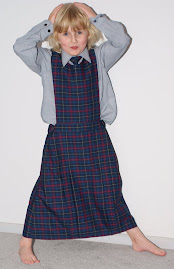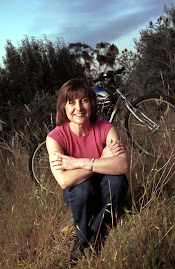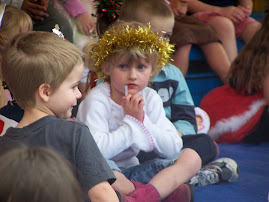Recently I read some information about TV programmes targetted to young children. Programmes exclusively directed at young girls didn't appear until the early 1980s. Strawberry Shortcake and My Little Pony being the first two that contained all-girl characters and in settings that were unmistakenly feminine. The literature stated that before this time, young girls had to cross-over into the masculine domain and watch shows that were all about boys and boys adventures. This also meant that girls had to watch masculine based storylines and plots. Of particular note are characters set in eternal conflict with each other, such as Sylvester and Tweetie, RoadRunner and Coyote, Bugs Bunny and Elmer Fudd.
But Strawberry Shortcake and My Little Pony, directly aimed at little girls, had storylines and plots that minimised conflict and highlighted friendships, relationships, feelings and sharing. My Little Pony was different in that its setting was outside. Prior to this nearly all female characters were placed inside and were affiliated with their male counterparts. Characters such as Daisy Duck, Minnie Mouse who were given high heeled shoes and voluptuous breasts were relegated mostly to inside (domestic) and affiliated with a love interest. Miss Piggy broke this mold somewhat, as in being assertive and outside/sporty but remained fixated with Kermit and was given enormous breasts, and in fact, her sexuality has been used as an asset and somewhat exploited. Even Pebbles, as a baby, was silent, and had her eyes on Bamm-Bamm, who was loud and noisy. I also learned that in the past, any female icon used to sell products/games/toys has spelt doom and hence, all icons associated with products, such as Ronald McDonald have remained male. This brought me to remembering characters from my childhood, such as Humphrey B Bear and Fat Cat, and guess what? They all turned out to be male characters.
So, with some history of young children's shows, I decided to watch a few days of what's available today, and was surprised to learn that not much has changed. Female characters are still mostly indoors, aligned with domestics, offered up as love interests (usually to the main male character), are given supporting roles only, or are used to resolve the conflict and chaos created by the male characters. There was one exception. Dora the Explorer. From what I could find Dora is the only female lead character that does not rely on male characters to help her out, or is in love with any of them, is not sexualised, makes all her own decisions and uses resources around her to get where she needs to be. But since Dora hit the screens, we have seen Go Diego Go! which is a male version of Dora, and in Diego's series Dora appears as his side-kick, not as a central figure. I'm unsure if Diego appears in Dora's series as a secondary figure.
Here's a run-down of some of the shows I managed to analyse:
Shaun the Sheep - male, outside, adventurous, mischevious, resourceful. The two female characters are Shirley who is extremely fat and eats everything, and a mother sheep with a baby and is characterised by having curlers in her hair.
Andy Pandy - male, adventurous and all other characters are male, except Lindy Lou who provides biscuits and Missy Hissy who is a snake.
Bill and Ben - male, outside, adventurous, mischevious and very resourceful. There are now 12 characters in Bill and Ben, and the three static characters of Rose, Thistle and Little Weed are all female.
Little Einsteins - rocket is the main character and is referred to as a "he". The four "little Einsteins" characters of 2 girls and 2 boys play supporting roles only, and it is Rocket that is given hero status.
Imagination Movers - 4 male lead characters who do all the imagining, with a boring Uncle who is accompanied by a female who is his secretary. The 2nd series gives the token female a bit more autonomy than the first series where she was relegated to smiling nicely and not saying very much. She is a major support role for the most boring character in the series.
My Friends Tigger and Pooh - all male cast, except for Darby who is a girl. Her role is a major facilitator in keeping the group of friends in harmony and sorting out any problems they may have assisted by Pooh, Piglet and Tigger.
Charlie and Lola - both male and female and additional characters are added in a 50/50 mix of male and female. While it seems that Lola is the main character in this series, the stories are actually Charlies. Each episode (and book) starts with "I have this little sister Lola, she is small and very funny." Thus putting the setting of the differences between the siblings right out in front.
Fifi and the Flower Tots - mostly female cast. Other than Bumble who is a close friend and helper to Fifi the other 2 male characters (Stingos and side-kick) are "baddies" and need to be put in their place, usually by Fifi who takes on the responsibility for their bad behaviour and tells them the error of their ways.
Bo on the Go - female. This show almost does a Dora. Only almost in that whenever Bo reaches a problem, she conjures up a male wizard who gives her the answer.
Odd Jobbers - male, with the only females in the show I watched given domestic roles.
Mickey Mouse Clubhouse - all male, except for Daisy and Minnie, as mentioned earlier, only in the more modern series, their breasts have been removed. They still have high heeled shoes and the bows in their hair have taken on unbelievable dimensions.
Bob the Builder - male, and in charge and in a male working role. Wendy is Bob's support character, who at times, will take on the responsibility of organising him and is his sometime love interest. The other female character is a cement mixer named Dizzy.
Handy Manny - male and in charge and in a male working role. Some tools in his box are female.
Roary the Racing Car, Brumm, and there's one about a fire engine who's learning the ropes - all male.
After doing this analysis on animated pre-school and early school aged programmes, I came to the conclusion that not too much has changed since before the 1980s. Male roles are overwhelmingly situated outside, adventurous, mischevious, chaotic, disorganised, mobile, in charge, in working roles of traditional breadwinners, domestically challenged, assertive and sometimes aggressive, scheming and plotting for personal gain.
On the other hand, female characters are overwhelmingly in supporting roles to male leading characters, in that they are either affiliated with them as a love interest, as their secretary and organiser, and/or as "fix-its" so that the male characters don't experience the full consequences of their actions. In situations when they do experience consequences it has been the action of the female characters that have brought their deeds to light. Some female characters are excessively passive, in that they can't move, and are often depicted in domestic roles of providing biscuits, cooking, making up the picnic basket and/or indoors baking. Violet and Primrose in Fifi and the Flowertots are locked in a competition of looks and vanity.
The only exception is Dora the Explorer and to a lesser extent, Bo on the Go. Programmes designed for young children conform to strong gender roles and depict storylines and characters within the confines of social expectations of what girls and boys should, or should not, be doing.
QotD: “Things went wrong the moment Blue decided to treat her fellow human
beings as depersonalized objects, and to let them treat her like an object
in turn”
-
Kathleen Stock (who I also quoted in my ‘The Dystopia of OnlyFans’ post)
has also written about the Bonnie Blue documentary; I would recommend
reading Stoc...
5 months ago











